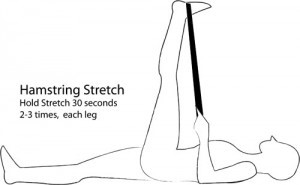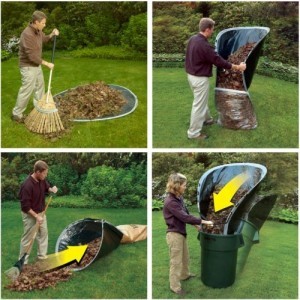Safe Leaf Raking Tips
- Loosen muscles and joints. Warm up with light movement or a brisk walk to loosen your muscles and increase your flexibility. Doing a few stretches after you are done is a great idea as well.
a) Cold, tight muscles are more prone to injury than warmed up, flexible muscles.
b) Do your back a favor by warming up for five to ten minutes before raking or any strenuous activity.
c) Get your blood moving with a brisk walk, marching in place, or another full-body activity.
d) Stretch your low back and hamstrings (the large muscles in the back of the thigh) with some gentle stretching exercises. The easiest way to do this is lying down on the ground with one leg straight down and the other being pulled towards your body. Hold this stretch for 30 seconds to one minute, repeat and do the same on the other leg. (see picture below)

- Pace Yourself. Take frequent breaks to rest and gently stretch your back, arms, and legs. If you experience pain or run shortness of breath, seek immediate assistance.
- Choose a rake that is right for you.
- Standing. Rise up from the ground by straightening your legs at the knees, not by lifting your torso at the waist.
- Smaller loads. Lift loads close to the body’s torso and center of gravity, and handle smaller, more manageable loads at a time.
- Gloves. Gloves should be form-fitting. Thin gloves are preferred; too much padding will decrease hand strength, coordination and power grip.
- Gripping. When you grip the rake, make sure your hands are at least shoulder width apart and your feet are shoulder width apart.
- Lifting.To avoid lifting, rake leaves onto a canvas tarp. When full, pull the tarp and unload the debris to the desired location.
- Shoes. Shoes or boots with good treads will help to minimize injuries from slipping.
- Come see us – Make a habit of regular chiropractic adjustments to ensure an optimally functioning musculoskeletal system and help make your outdoor work more enjoyable and injury-free!

